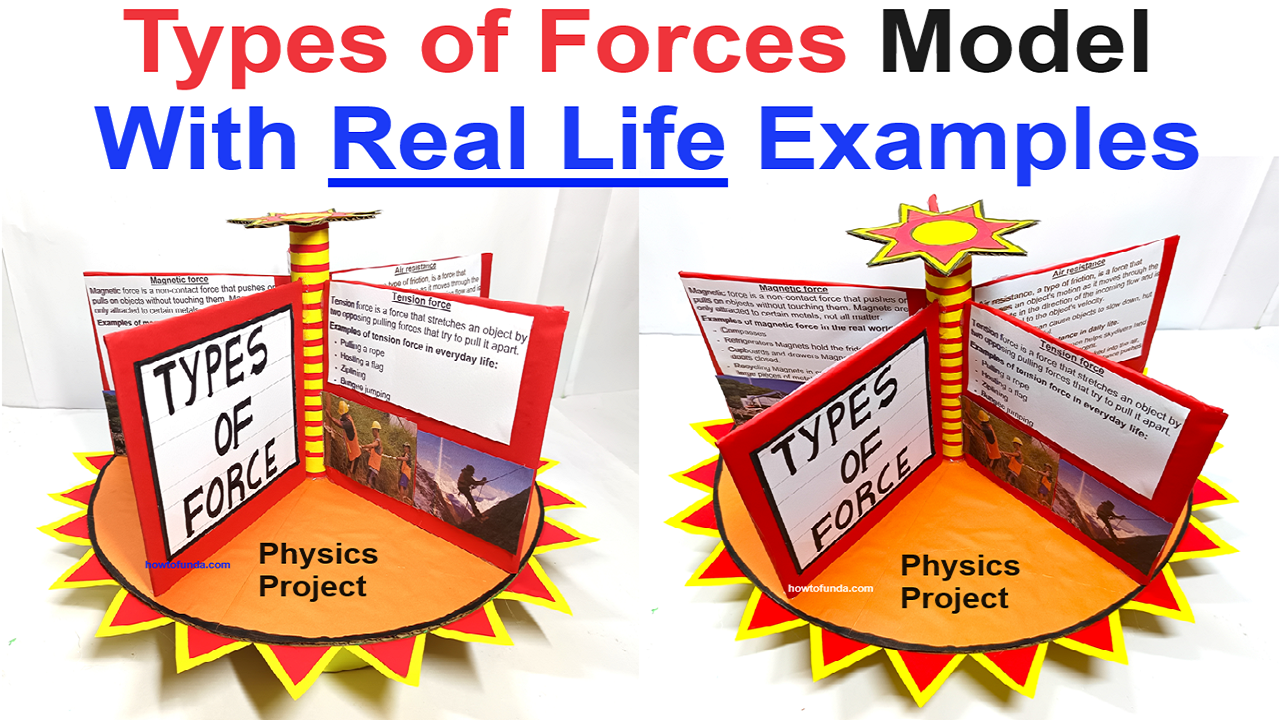Creating a physics project model to demonstrate different types of forces using cardboard and colored paper can be an engaging way to learn about these concepts.

Here’s a step-by-step guide to make this model with 8 partitions, each representing a different type of force:
Materials Needed:
- Cardboard
- Colored paper
- Scissors
- Glue
- Ruler
- Marker
- Small objects for demonstrations (e.g., magnets, rubber bands, small weights, etc.)
Steps:
1. Prepare the Base:
- Cut the Cardboard Base: Cut a large piece of cardboard (around 60 cm x 40 cm) to serve as the base of your model.
- Cover with Colored Paper: Cover the cardboard base with colored paper using glue to make it visually appealing.
- Draw Partitions: Using a ruler and marker, divide the base into 8 equal sections. Each section will represent a different type of force.
2. Create the Force Demonstrations:
1. Frictional Force:
- Example: A toy car moving on different surfaces.
- Setup: Attach small pieces of different textured materials (sandpaper, smooth paper) to the base. Place a small toy car on each surface to show how friction affects its movement.
2. Gravitational Force:
- Example: An object falling.
- Setup: Glue a small figure or object to the top of a vertical strip of cardboard. Attach this strip to the partition and draw arrows to show the direction of gravitational pull.
3. Tension Force:
- Example: A stretched rubber band.
- Setup: Attach a rubber band between two small posts made from cardboard. Show how pulling on the rubber band creates tension.
4. Electrical Force:
- Example: Static electricity attracting small pieces of paper.
- Setup: Use a small balloon or comb rubbed on wool to attract tiny pieces of paper. Glue this setup in the partition and add arrows to show the direction of the electrical force.
5. Normal Force:
- Example: A book resting on a table.
- Setup: Create a small cardboard table and place a miniature book or a block on it. Draw arrows to show the normal force acting perpendicular to the surface.
6. Magnetic Force:
- Example: Magnets attracting or repelling.
- Setup: Attach small magnets to the partition and place them in such a way to show attraction or repulsion. Use arrows to indicate the magnetic force direction.
7. Air Resistance Force:
- Example: A parachute slowing down a falling object.
- Setup: Create a small parachute using a piece of fabric or paper attached to a lightweight object. Show how the parachute slows the descent due to air resistance.
8. Applied Force:
- Example: Pushing a block.
- Setup: Place a small block and a figure pushing it. Draw arrows to indicate the direction of the applied force.
9. Spring Force:
- Example: A compressed or stretched spring.
- Setup: Attach a small spring (can be made from a wire or found from an old pen) to the partition. Show how compressing or stretching the spring creates a force.
3. Add Labels and Explanations:
- Label Each Partition: Use markers and colored paper to create labels for each type of force. Place the labels at the top of each partition.
- Write Explanations: Write brief explanations of each force on small pieces of colored paper. Attach these explanations within each partition to describe the real-life example and how the force works.
This project will help visually demonstrate and explain various types of forces through real-life examples, making the concepts more relatable and understandable.

